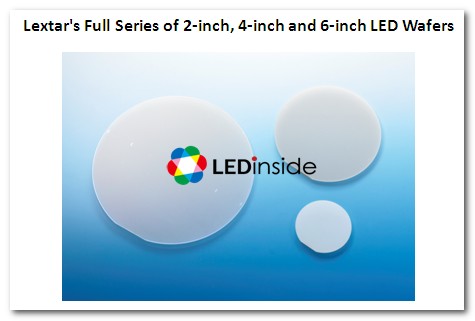LEDinside: LED Perspective from Dr. David Su, Chairman of Lextar
Lextar is the only LED manufacturer in Taiwan that adopts a business model which includes up, mid, downstream production lines and product applications. LEDinside had the honor to interview Lextar’s Chairman Dr. David Su and talked about the vertical integration strategy, the future development of the lighting market and the development strategies in the Chinese market. Dr. Su also sheds light on the current development of Taiwanese LED industry.

Vertically Integrated Model: Lower Cost, Higher Efficiency and Faster Response
Lextar is a subsidiary of AU Optronics Corp, the largest panel manufacturer in Taiwanese panel industry, whose market is oligopolistic and the market share is steady. Most panel manufacturers establish their own plants for manufacturing LED backlight products with the vertically integrated model, which helps the companies to attain economies of scale, better efficiency, up-to-date information about the product specification development and faster response to changing market demand. Lextar, invested by AU Optronics Corp, focuses specifically on providing panels with LED backlight. Only by establishing its in-house LED supply chain can AUO achieve cost competitiveness, which is the main goal to pursue vertical integration. The vertical integration business model holds many advantages: 1. Enhance knowledge management, which enables a fast information transmission from the terminal to the management team. 2. Simplify human resource management. 3. Improve the ability of handling counteroffers. 4. Achieve a faster response in terms of customer service. Without vertical integration, a company will have to examine every possible cause when coping with customer complaints, which will result in a delayed response and slow operations.
Before Lextar adopted the vertical integration model, when encountering problems, every subsidy still made the maximum profit a priority over finding a solution. However, after adopting the vertical integration model, Lextar can not only succeed in optimizing efficiency and increasing its competitiveness, but also obtain a more advanced knowledge of end-market applications, which enables a faster response to the changing market demand.
A Balance between Competition and Cooperation to Maintain Flexibility
Currently, major panel manufacturers have all adopted the vertical integration model. For example, Samsung not only has established a solid brand but also owns an exclusive channel, along the line with effort of purchasing glass faceplates to pursue its vertical integration. Due to the fact that major manufacturers have established their in-house supply chains, when encountering supply shortage, the purchasing decision becomes much more flexible. However, for other LED manufacturers, there is bound to be the crowding out effect in the long run.
Despite the vertical integration model, chip out-sourcing still accounts for 20% of Lextar’s chip in-house ratio, even if there is surplus capacity, which is because of the following reasons: 1. To maintain contacts with chip makers. 2. It can signify the market changes and in turn stimulate the optimization of the chip production, and keeps the company from slacking in spite of the fact it owns exclusive channels. 3. From the perspective of risk management, maintaining a certain amount of chip out-sourcing helps reduce the production risk. As for Lextar’s vertical integration mode, its goal is to provide products for their main clients such as panel manufacturers and lighting manufacturers. Therefore, Lextar does not need to be the top competitor either in the chip industry or to other chip makers.

Lextar’s Development Strategy in the Chinese Market
Due to the cluster effect of the panel industry and the fact that most lighting product manufactures are located in China, where the cost is low and the government offers subsidies, Lextar has started building a new plant in the Suzhou Industrial Park, which is to be finished this year in order to supply the panel and lighting product demand.
The perspective of Lextar in the LED lighting market: providing optical, mechanical, electronic and thermal solutions
The differences that distinguish the traditional lighting industry from the LED lighting industry are that goods of the former are gas illumination, standardized, mass-produced, regional-distributed and have specific standards and preferences with a clear division of labor. It is very difficult for the traditional lighting manufacturers to make a breakthrough into the LED lighting industry, because for them, LED lighting is an emerging industry-the production for LED lighting applications will increase the business risk. On account of the fact that the future of LED lighting industry lies in optical, mechanical, electronic and thermal solutions, Lextar’s vertical integration model will be the most accessible route toward that direction.
The next challenge for Lextar: to become a world class LED company
The R&D team of Lextar has been putting the accent on the development of LED light source and lighting module and providing customized solutions according to different markets and clients, including technology, design and total solution of light source and module for major manufacturers, brand vendors and local lighting companies. The panel market is oligopolistic: the top ten panel manufacturers take up the major channels and outlets, which makes it easy to dominate market share. However, unlike the panel market, the competition among manufacturers in the lighting market is fierce, and the cooperation with distributors and brand vendors and technology exchange are indispensable. Hence, striving to become the total solution provider regarding the light source technology in the lighting market, while Lextar seeks partnership, the ability of manufacturing lighting products will be taken into account with the aim of integrating with Lextar’s light engine module and optical, mechanical, electronic and thermal solutions: despite different light product designs, the light engine Lextar provides is the same. The future trend of LED lighting is the smart lighting solution with integrated light source: through solid-state lighting applications, the designer creates an environment by controlling the lighting in response to different daily schedules and moods. Since its establishment in 2008, with the motto of “Smart Lighting, Amazing Life,” Lextar has been targeting at the prospects of the lighting market in the hope of becoming a world class LED company.

By Lowy Chang














